Discuss major types of Psychotropic drugs, their examples and effects on Human body.Solution in Punjabi
I. Psychotropic Drugs.
These drugs act on the brain and alter behaviour, consciousness and capacity of perception. Hence, they are also termed mood-altering drugs. The repeated use of the psychotropic drugs makes the bddy dependent on them. The psychotropic drugs are classified into four major groups : tranquillizers, sedatives and hypnotics, opiate narcotics and stimulants.
1. Tranquillizers. The tranquillizers lessen tension and anxiety, and promote calmness and soothing without sedating or depressant effect and do not induce sleep. Examples : phenothiazines and benzodiazepines.
(a) Phenothiazines. These are antipsychotic drugs. In a psychotic patient, they decrease aggressiveness, remove anxiety and normalise thought and behaviour. Phenothiazine is a parent compound for the synthesis of several antipsychotic drugs, i.e., chlorpromazine, thioridazine, reserpine, etc.
(b) Benzodiazepines. These are antianxiety drugs. Anxiety is a disturbance of mind involving restlessness, tension, worry of some uncertain event, apprehension of fear and danger. A certain degree of anxiety is a normal phenomenon in life. However, frequent and excessive anxiety need treatment with benzodiazepines. The latter have gained popularity over the barbiturates (described ahead) because of more effectiveness, almost no side effects and mild withdrawal symptoms. Benzodiazepine is a parent compound for the synthesis of many antianxiety drugs, such as diazepam (valium, calmpose), oxazepam, chlonazepam, etc. Diazepam is hypnotic (sleep inducing), antianxiety and anticonvulsant agent. Oxazepam is an antianxiety drug. Clonazepam is an anticonvulsant drug.
Benzodiazepines should be taken in small dozes and should be given up when not needed.
2. Sedatives and Hypnotics.
The sedatives depress (“switch off.) the activities of the central nervous system. They reduce excitement, assuge pain, and give a feeling of calmness, relaxation or drowsiness. Higher doses induce sleep. The sleep-inducing drugs are also called hypnotics. Examples : barbiturates and benzodiazepines.
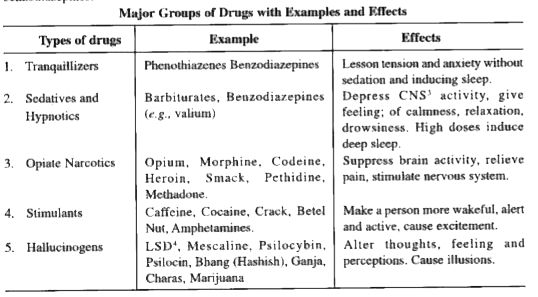
(i) Barbiturates. Barbiturates are synthetic drugs derived from barbituric acid. They are general depressants and are popularly called sleeping pills. They lesson functional activity, decrease anxiety and induce sleep. Their repeated use causes psychological dependence. It is very difficult for the addict to withdraw from them. Withdrawal causes depression and/restlessness. Repeated use leads to barbiturism involving skin eruption accompanied by chill, fever and headache. Barbiturates are not preferred these days.
(ii) Benzodiazepines. These are antianxiety as well as sedative drugs, and have been described earlier.
Due to the antianxiety and antitension properties of the sedatives-hypnotics, their abuse has dramatically increased.
3. Opiate Narcotics.
Medical Use. The opiate narcotics are drugs that suppress brain activity and relieve pain. They are popularly called pain killers. They also have sedative and astringent effect. An astringent causes contraction of a tissue, arrest of secretion, or control of bleeding. The opiate narcotics are also used for cough relief and for the treatment of vomiting and diarrhoea.
Examples. The opiate narcotics are briefly called opiates or opioids. They include opium and its derivatives , certain semisynthetic compounds, namely, heroin and smack, and some synthetic drugs such as pethidine and methadone.
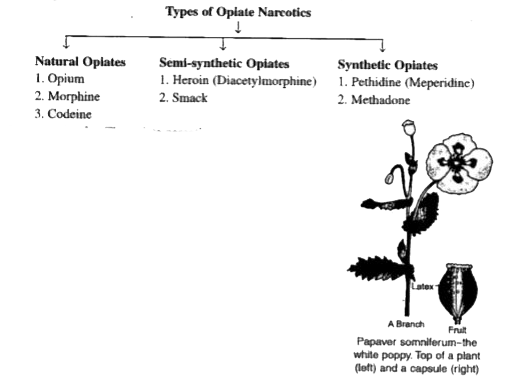
Forms of Intake. The opiate narcotics may be eaten, smoked, sniffed or injected intravenously.
Dependence. The opiate narcotics cause a high degree of dependence in their users.
General Effect. The opiates, in general, relieve pain, reduce tension and anxiety, lower blood m pressure and breathing rate, induce drowsiness and lethargy, reduce glandular secretion, impair digestion and speech, cause nausea and vomiting, produce sterility, and constrict the pupil, reducing visual acuity. "An overdose may stop respiration and cause death. If the drugs are not available, the addict shows terrible withdrawal symptoms.
The opiates also depress the immune system, especially the cells that fight cancer and virus infection. Therefore, the opiate dependents readily catch infectious diseases such as tuberculosis.
(i) Opium. Opium is the air-dried, milky latex obtained by incising the unripe capsules (fruits) of white poppy plant, Papaver somniferum (family Papaveraceae) or its variety, P.album. It has reddish brown colour, heavy smell and bitter taste. Opium has been used as a drug since ancient Greek times, because it is the most effective pain killer and also induces a state of euphorial, an exaggerated feeling of well being, also called .high.. Opium is eaten or smoked. Some persons in villages take opium in its raw form.
The opium dependent loses weight, fertility and interest in work.
Opium Derivatives. Opium contains some 20 alkaloids. Its main derivatives are morphine and codeine.
(ii) Morphine. It is the active principle of opium. It was isolated by Serturner in 1805, and he named it after the Greek god of dream or of sleep. Morpheus. Morphine is the most valuable analgesic. It is also used as a sedative and an anxiolytic (antianxiety) agent. It forms about 10% of the dried exudate of poppy. It is widely used in small doses to relieve pain and induce sleep in cases of serious injury, burns, fractures and surgeries. However, us continued use causes dependence.
Morphine reduces heart beat, blood pressure and urine output, increases blood sugar and causes constipation.
(iii) Codeine. It may be obtained from opium or morphine. It is, in fact, methylmorphine. Opium contains 0.7 to 2.5% of codeine (G. kodeia = head, poppy head). It has mild analgesic properties. It does not cause addiction. It is an ingredient of many medicines and cough syrups. A notable side effect of codeine is constipation.
(iv) Heroin (Diacetylmorphine or Diamorphine). Heroin is a white or brown, crystalline semisynthetic compound prepared from morphine by acetylation. It is the most dangerous opiate. It is twice as potent as morphine and about 200 times stronger than opium. It was formerly used for the relief of cough. It is highly addictive. It is banned even for medical use, except for research. It is prepared and sold illegally because it gives huge profit. International efforts are being made to check its trafficking.
Heroin may be orally taken, inhaled or injected. Vt induces drowsiness and lethargy. Its after- effects include impaired digestion, decreased weight, reduced vision, sterility and total loss of interest in work. There are additional risks in its use. Being costly, it is often diluted with harmful substances which may cause secondary illness. Syringes and needles used for injection are not sterilized. This may cause blood poisoning, serum hepatitis, abscess formation and AIDS.
Withdrawal symptoms of heroin include vomiting, diarrhoea, shivering, running nose, muscular cramps and epilepsy.
(v) Smack. It is a crude by-product of heroin synthesis, and is commonly called "brown sugar". Being cheap, it is considered "poor man.s heroin”. The addicts heat the smack powder and inhale its vapour. Smack is diactylmorphine hydrochloride. It is a stronger analgesic than morphine.
(vi) Pethidine ( Meperidine Hydrochloride). Pethidine is a widely used narcotic analgesic. It has sedative and euphoriac effect also. It has a local anaesthetic action.
(vii) Methadone. Methadone is an orally effective analgesic. Its action is slightly stronger and longer than that of morphine. It causes psychic and physical dependence, but withdrawal symptoms are mild. It is also used during withdrawal treatment in morphine and heroin addiction. Methadone has a reduced sedative action.
4. Stimulants.
The stimulants temporarily stimulate the nervous system, make a person more wakeful, alert and active, and cause excitement. The stimulants do not cause physical dependence because no withdrawal symptoms appear. Psychological dependence is very likely to occur as withdrawal causes depression, anxiety and restlessness. The stimulants include caffeine, cocaine, crack, betelnut and amphetamines.
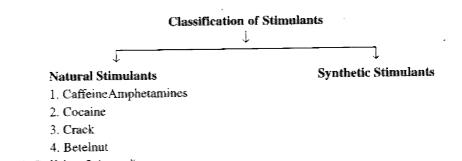
(i) Caffeine. It is a mild stimulant. It is 1, 3, 7-trimethylxanthine.
Source. Caffeine is a vegetable alkaloid obtained from the dried leaves of tea plant (an evergreen shrub named Thea sinensis) of family Theaceae, dried beans (seeds) of coffee plant (a shrub called Coffea arabica) of family Rubiaceae, and dried seeds of cacao plant (a small, evergreen, tropical American tree named Theobroma cacao) (G. theos = a god, brom = food).
Appearance. Caffeine is white, crystalline, slightly bitter alkaloid.
Mode of Use. Caffeine is commonly taken as beverages-tea, coffee, cocoa and cola drinks. It is also taken in chocolate bar and chocolate confectionary.
Effect. Caffeine increases the metabolic rate of neurons, thereby increasing alertness and thought. It improves performance and removes boredom, Higher doses cause nervousness, restlessness and insomnia. Excessive intake of caffeine causes addiction.
Medical Use. Caffeine is used in medicines as a cardiac and respiratory stimulant, as a diuretic, and in the treatment of headaches.
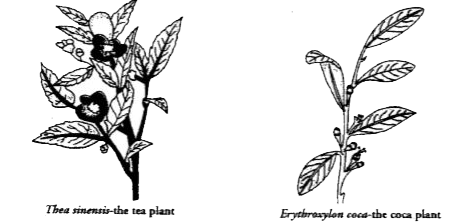
A cup of tea contains 30-75 mg. of caffeine and 200 ml. of cola drink has 25-60 mg. Chocolate bar and the drug anacin also contain caffeine. Twenty cups of coffee taken at a time may be fatal.
Excessive use of coffee is harmful. It may cause anxiety, irritability, diarrhoea, irregular heart beat (arrhythmia) and decreased concentration. It also causes indigestion and disturbs pancreatic and renal functions. If taken empty stomach, it can cause stomach ulcers.
Withdrawal Symptoms. Withdrawal from caffeine leads to headache, disturbed sleep, lethargy, etc.
(ii) Cocaine (Coca alkaloid). It is benzoylmethylecgo- nine, an alkaloid.
Source. Cocaine is extracted from the dried leaves and young twigs of the South American shrub named Erythroxylon coca. It is not connected with the beverage cocoa. .
Appearance. Cocaine is a white, crystalline bitter powder.
Medical Use. Cocaine is a vaso-constrictor and it, therefore, used as a local anaesthetic.
Mode of Intake. Cocaine is chewed, eaten or sniffed in its powder form or taken as a drink. It is injected also.
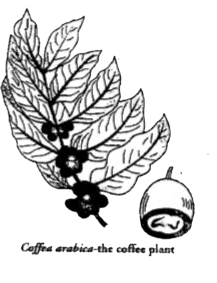
Effect. Cocaine is a CNS stimulant. It increases mental alertness and physical strength. It gives a feeling of well being and delays fatigue. It causes lack of sleep and loss of appetite. It is taken for excitement by addicts. Its use may ultimately lead to mental disorder and insanity. Its overdose may cause severe headache, convulsions and death due to respiratory or cardiovascular failure.
(iii) Crack. It is a highly potent smokable derivative of cocaine. When smoked, it results in a brief, intense .high.. Within 10 seconds of being smoked, it provides a dramatic .high. lasting for 3- 5 minutes, and afterwards an intense craving for the drug arises in the user. Dependency can develop in less than 2 weeks. Crack is relatively cheap but extremely addictive. Crack may cause complications such as heart and nasopharynx damage, seizures (epileptic attacks), and mental problems.
Crack is also sold as ridged lengths called "teeth" or "french fries".
(iv) Betelnut. Kemel of the betelnut palm, Areca catechu, enclosed in betel leaves and mixed with an aromatic paste is chewed extensively in India and Africa. It contains an alkaloid arecoline (C8H13NO2) and a red tannin. It is a mild CNS stimulant. It stains teeth and gums red.
(v) Amphetamines. These are synthetic drugs, commonly called pep pills or antisleep drugs.
Effect. The amphetamines are strong CNS stimulants and produce increased self-confidence and flow of ideas besides causing excitement and alertness. They are thought to increase physical and mental performance. They are taken by truck drivers, students and night workers to keep awake. They impair judgement and vision. This may result in road accidents. They do not remove fatigue. They cause addiction.
Medical Use. Amphetamine (CgH(13)N) is used as a spray or inhalant for the relief of cold, asthma, etc.
Amphetamines are among the “dope test” drugs for athletes who use them to stimulate physical and psychological strength. They suppress hunger and are used to reduce weight.
Harm. High doses of amphetamines cause sleeplessness which may lead to mental confusion. Their use may produce after effects like nausea and vomiting.
Use of stimulants has become routine. It is difficult to imagine the life without tea, coffee, cola drinks and betel.
Topper's Solved these Questions
- HUMAN HEALTH AND DISEASEBOOK - BETTER CHOICE PUBLICATIONCHAPTER - HUMAN HEALTH AND DISEASEEXERCISE - LONG ANSWER TYPE QUESTIONS (MOST EXPECTED QUESTIONS)
12 Videos
- HUMAN HEALTH AND DISEASEBOOK - BETTER CHOICE PUBLICATIONCHAPTER - HUMAN HEALTH AND DISEASEEXERCISE - SHORT ANSWER TYPE QUESTIONS(MOST EXPECTED QUESTIONS)
9 Videos
- EVOLUTION BOOK - BETTER CHOICE PUBLICATIONCHAPTER - EVOLUTION EXERCISE - LONG ANSWER TYPE QUESTIONS (5 Marks) (MOST EXPECTED QUESTIONS)
13 Videos
- HUMAN REPRODUCTIONBOOK - BETTER CHOICE PUBLICATIONCHAPTER - HUMAN REPRODUCTIONEXERCISE - LONG ANSWER TYPE QUESTIONS
40 Videos
Similar Questions
Write the causative organism, mode of infection, symptoms and preventive measures of the disease pertussis.
View SolutionDraw a well-labelled diagram of an antibody molecule.
View SolutionExplain Human Evolution.
View SolutionWhere does Oogenesis occur in humans? Describe the stages of the process.
View SolutionWhat is true of the psychotropic drug ?
View Solutionसाइकोट्रॉपिक ओषधियाँ क्या है ? दो उदारहण दीजिये ।
View Solutionसाइकोट्रॉपिक औषधियों पर टिप्पणी कीजिए।
View SolutionName four types of psychotropic drugs. Give one example of each.
View SolutionWhat is psychotropic drugs ?
View SolutionWhat is drug addiction ? Discuss different types of drugs and their effects.
View Solutionसाइकोट्रोपिक ड्रग्स पर टिप्पणी लिखें।
View SolutionWhy are stimulants and hallucinogens categorised as psychotropic drugs? Give one example of each of the two types of drugs mentioned.
View SolutionName the type and give the effects of the LSD drug in human.
View SolutionName the type and give the effects of the Morphine drug in human.
View SolutionName the type and give the effects of the Barbiturates drug in human.
View Solution
